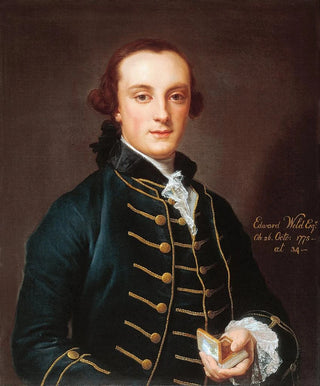Art print | Edward Weld - Pompeo Batoni


View from behind

Frame (optional)
In the fascinating world of art, some works transcend time and continue to captivate minds. The art print Edward Weld - Pompeo Batoni is a perfect example. This painting, which evokes an era when elegance and refinement were at their peak, transports us to the heart of the 18th century—a period marked by major artistic and cultural upheavals. Batoni's work, distinguished by its ability to blend realism and idealization, offers a valuable glimpse into the aristocratic society of his time. By contemplating this piece, the viewer is invited to immerse themselves in a visual narrative rich in emotion and meaning.
Style and uniqueness of the work
The uniqueness of "Edward Weld - Pompeo Batoni" lies in the artist's technical mastery, who manages to capture not only the physical traits of his subject but also their spiritual essence. Batoni, known for his portraits of remarkable precision, uses delicate play of light and shadows to emphasize the depth of expressions. The chosen colors, both vibrant and harmonious, create an atmosphere of serenity and dignity. Every detail, from the draping of clothing to carefully selected accessories, reflects meticulous care and attention to aesthetics. This work does not merely depict an individual; it tells a story, that of a man of his time, Edward Weld, whose gaze seems to carry the weight of his reflections and aspirations.
The artist and his influence
Pompeo Batoni, an emblematic figure of Italian painting, established himself in the 18th century as one of the most sought-after portraitists of his era. His style, marked by a neoclassical influence, fits within a tradition that values ideal beauty while remaining rooted in reality. Batoni skillfully integrated elements of classical culture into his works, creating a bridge between the past and the present. His ability to capture the personality of his subjects while placing them in historical or mythological contexts had a lasting influence on his contemporaries and subsequent generations. As an artist, he not only contributed to the evolution of the portrait, but

Matte finish

View from behind

Frame (optional)
In the fascinating world of art, some works transcend time and continue to captivate minds. The art print Edward Weld - Pompeo Batoni is a perfect example. This painting, which evokes an era when elegance and refinement were at their peak, transports us to the heart of the 18th century—a period marked by major artistic and cultural upheavals. Batoni's work, distinguished by its ability to blend realism and idealization, offers a valuable glimpse into the aristocratic society of his time. By contemplating this piece, the viewer is invited to immerse themselves in a visual narrative rich in emotion and meaning.
Style and uniqueness of the work
The uniqueness of "Edward Weld - Pompeo Batoni" lies in the artist's technical mastery, who manages to capture not only the physical traits of his subject but also their spiritual essence. Batoni, known for his portraits of remarkable precision, uses delicate play of light and shadows to emphasize the depth of expressions. The chosen colors, both vibrant and harmonious, create an atmosphere of serenity and dignity. Every detail, from the draping of clothing to carefully selected accessories, reflects meticulous care and attention to aesthetics. This work does not merely depict an individual; it tells a story, that of a man of his time, Edward Weld, whose gaze seems to carry the weight of his reflections and aspirations.
The artist and his influence
Pompeo Batoni, an emblematic figure of Italian painting, established himself in the 18th century as one of the most sought-after portraitists of his era. His style, marked by a neoclassical influence, fits within a tradition that values ideal beauty while remaining rooted in reality. Batoni skillfully integrated elements of classical culture into his works, creating a bridge between the past and the present. His ability to capture the personality of his subjects while placing them in historical or mythological contexts had a lasting influence on his contemporaries and subsequent generations. As an artist, he not only contributed to the evolution of the portrait, but






